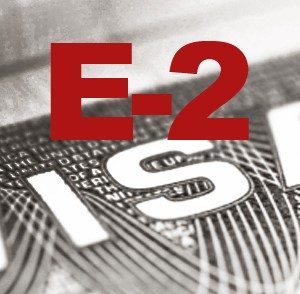11 May Why Isn’t my Country Eligible for E-2 Status?
Some foreign nationals seeking admission to the United States are not eligible to apply for the E-2 Treaty Investor visa. This is the case for citizens of Brazil, Venezuela, Mainland China, India, and a number of other countries that have not yet signed an applicable investment treaty with the United States. Foreign nationals who do not come from a “Treaty Country” must find alternate options for coming to the U.S. to invest in and manage a business.
In this article, we will briefly review how a nation can become an E-2 Treaty Country and why some states have not yet concluded an investment treaty with the United States. (The full list of Treaty Countries can be found here.)

A Brief History of Investor Treaties
Since its founding, the United States has signed treaties of trade and/or investment with many other countries. Such treaties are intended to promote bilateral trade and investment between the USA and the contracting state, thereby encouraging good relations, economic growth, and peace.[1]
After World War II, the United States sought to facilitate private international investment by signing Treaties of “Friendship, Commerce and Navigation” with over two dozen countries.[2] As of the 1980s, investment provisions are typically included in Free Trade Agreements (of which the United States has 20 currently in force) or in standalone compacts called “Bilateral Investment Treaties” (BITs). [3] BITs establish the terms and conditions for private investments made by individuals and business entities from one sovereign state in another sovereign state.[4] Typically, nationals from countries that have signed a BIT with the USA are eligible to apply for an E-2 visa.
What do BITs do?
BITs are based on the concept of reciprocity. As such, they obligate foreign countries to provide American investors and companies with the same protections and rights that their citizens would receive in the United States. BITs further require that investors and their investments be treated “as favorably as the host party treats its own investors and their investments or investors and investments from any third country.”[5]
In addition to granting investors from a contracting state “fair and equitable treatment,” BITs also provide for the free transfer of funds in and out of the country as well as protection from expropriation. If an expropriation does happen, BITs ensure that investors are compensated in a fair and timely manner. BITs also provide investors recourse to arbitration, often under the auspices of ICSID (International Centre for Settlement of Investment Disputes), to resolve disputes with the host state.[6]
In sum, contracting countries must treat private investments in an open, transparent, predictable, and non-discriminatory manner.
Why isn’t my country eligible for E-2 status?
Foreign states that cannot guarantee the aforementioned protections and rights to American investors and their investments will be unable to conclude a BIT. Countries that are subject to international sanction or with which the United States has poor relations may also be excluded from such a deal.[7]
The explanation for why a particular country has not yet concluded a BIT with the United States is often complex, case-specific, highly politicized, and not always made public by the U.S. government.
Let us consider Mainland China, for example. Though China and the United States are currently in the process of negotiating a BIT, poor relations and China’s restrictive investment policies have hindered the development of an investment pact.
For example, China currently has ownership caps in about 100 industry sectors, including manufacturing, services, and agriculture. These caps are intended to prevent foreign companies from doing business in Chinese markets. By contrast, the U.S. restricts foreign investment completely in only five sectors, and maintains 24 minor conditions or restrictions that would be removed if the U.S. is given reciprocity in China.[8]
Additionally, China requires U.S. companies to meet disproportionate investment requirements, such as additional licensing standards that Chinese companies are not required to meet. As a result, American investors often face difficulties and delays when applying for business licenses in China. These unfair requirements would have to be eliminated for a BIT to be signed.[9]
Are there alternatives to the E-2 visa?
Foreign nationals who are not eligible to apply for an E-2 visa, can consider other visa categories, such as EB-5, in order to gain admission to the United States. Any foreign national can petition for an EB-5 visa. While the EB-5 visa has stricter investment and job creation thresholds than the E-2, it can result in legal permanent residence in the U.S. Basic requirements for an EB-5 visa are a $1,000,000 investment (or $500,000 in a Targeted Employment Area) in a new commercial enterprise and the creation of at least 10 full-time jobs within two years of being granted conditional permanent residency. See our comparison of the E-2 and EB-5 visas here.
Whichever visa option is pursued, the experts at e-Council Inc. know how to craft business plans that have the best possible chance of passing USCIS scrutiny. To find out about professional, well-researched, articulate, expository, narrative Visa Business Plans – whether for E-2, EB-5 or any other business-related visa – as well as a variety of ancillary and concierge services, all of which are designed to specifically address USCIS’s concerns, contact e-Council Inc.com at info@ecouncilinc.com.
e-Council Inc.’s website, newsletter and other forms of communication contain general information about legal matters. The information is not legal advice, and should not be treated as such. You must not rely on the information on this website as an alternative to legal advice from your attorney or other professional legal services provider. If you have any specific questions about any legal matter you should consult your attorney or other professional legal services provider.
[1] http://www.workpermit.com/us/investor_e1_e2.htm
[2] http://ir.lawnet.fordham.edu/cgi/viewcontent.cgi?article=2826&context=flr
[3]http://prospect.org/article/job-killing-trade-deal-you%E2%80%99ve-never-heard-china-bilateral-investment-treaty
[4] http://guides.ll.georgetown.edu/c.php?g=371540&p=2511827
[5] https://ustr.gov/trade-agreements/bilateral-investment-treaties
[6] http://guides.ll.georgetown.edu/c.php?g=371540&p=2511827
[7] https://ustr.gov/trade-agreements/bilateral-investment-treaties http://www.workpermit.com/us/investor_e1_e2.htm
[8] http://www.barrons.com/articles/a-treaty-setting-new-investment-rules-1418441035
[9] http://www.barrons.com/articles/a-treaty-setting-new-investment-rules-1418441035; http://www.reuters.com/article/us-china-usa-visas-idUSKCN0IU0Q020141110
